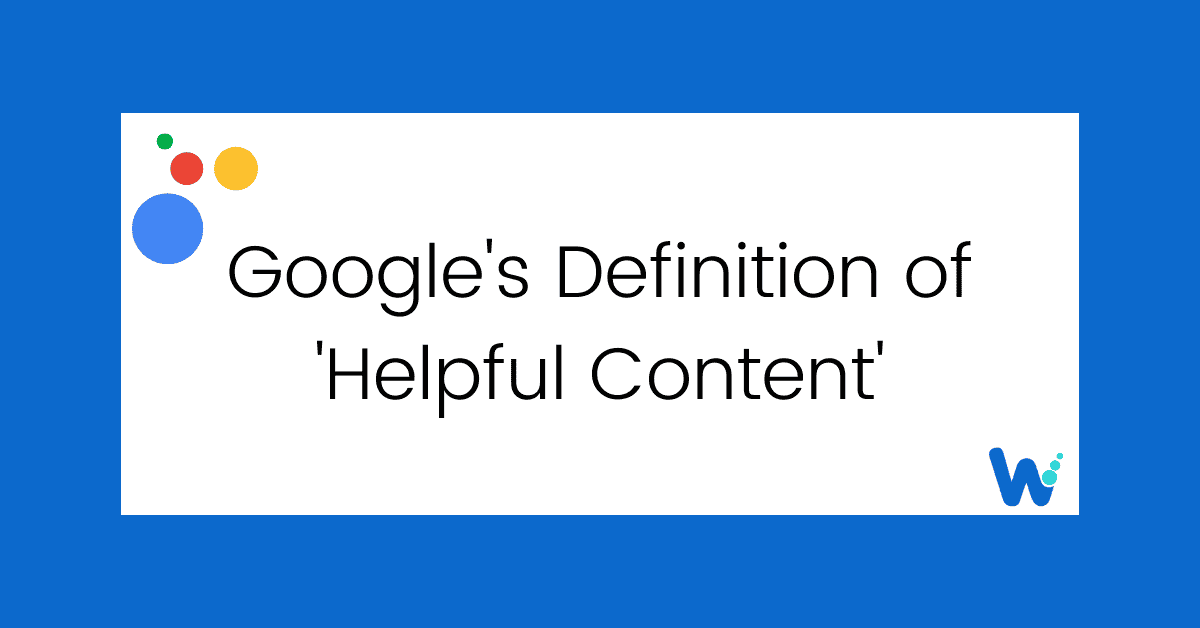Every blog post we read, video we watch, or social media post we encounter is a testament to the power of well-crafted content.
It can shape opinions, educate its audience, bolster sales, and much more.
Understanding Google’s perspective on “helpful content” is a guiding light for content creators.
By adhering to this view, creators ensure their content doesn’t just exist online but makes a significant impact on its intended audience.
The keyword “helpful” in Google’s mission deserves attention.
It emphasizes not just delivering information but delivering the most beneficial and apt information.
This is a clear message to content creators: your content should meet the user’s needs, addressing their questions and concerns comprehensively. Aligning with this principle ensures content resonates with the audience and mirrors Google’s objective.
Through this guide, we’ll dissect the concept of ‘helpful content’ from the lens of Google. We’ll journey through the evolution of search and understand how Google’s algorithms have been fine-tuned to favor content that adds genuine value to users.
We’ll break down the core elements of ‘helpful content’, focusing on aspects like relevance, expertise, authoritativeness, and trustworthiness. We will also discuss the role of tools like Google’s Knowledge Graph and Rich Snippets in elevating content quality.
This guide is designed to assist bloggers in understanding the complexities of creating content that is both valuable and recognized as ‘helpful’ in today’s online ecosystem.
The Changing Landscape of Search
Back in the day, making a website show up first on Google was a bit like a magic trick. People would repeat the same word many times in their articles, even if it didn’t make sense.
This was called ‘keyword stuffing’. It was like shouting louder than everyone else to get attention. But, the articles didn’t feel nice to read.
Google didn’t like that. They wanted people to find good stories and answers, not just loud ones. So, Google started changing the rules to make sure only the best and most helpful pages would come up first.
Google’s Rule Changes Over Time:
Panda (2011): Designed to reduce the prevalence of low-quality, thin content and to reward unique, compelling content. Sites with duplicate or plagiarized content, keyword stuffing, and user-generated spam witnessed a significant drop in rankings.
Penguin (2012): Targeted sites using manipulative techniques to achieve high rankings, often by buying links or obtaining them through link networks designed primarily to boost Google rankings.
Hummingbird (2013): This update was less about penalizing bad content and more about understanding user queries better. It placed a stronger emphasis on natural language processing, considering context and meaning over individual keywords.
Mobilegeddon (2015): With the rise of smartphones, mobile search skyrocketed. Recognizing this trend, Google rolled out this update to prioritize mobile-friendly sites.
BERT (2019): Perhaps one of the most significant leaps in the world of SEO, BERT focuses on interpreting the intent behind a user’s search, emphasizing the importance of context.
These updates, among others, reflect Google’s commitment to ensuring users find what they’re genuinely looking for, pushing webmasters to produce higher quality, more relevant content.
While the journey started with algorithms and keywords, the end game for Google was always the user.
Websites can no longer rank solely based on clever tricks or technical prowess; they need to serve the user’s intent effectively.
Today’s SEO landscape underscores a holistic approach. Visual content, user experience, website speed, mobile optimization, and social signals all play a crucial role alongside well-researched and well-presented content. SEO’s landscape has matured from a technical game to a user-centric discipline, emphasizing genuine value, relevance, and quality above all else.
Core Tenets of ‘Helpful Content’ as per Google
Search engines have been continually refining the criteria they use to rank content, and Google, as the industry leader, has placed a premium on delivering search results that are truly beneficial to users.
Understanding what ‘helpful content’ looks like from Google’s perspective can provide invaluable insights for content creators, marketers, and SEO professionals.
1. Relevance
At the heart of every search query is a question or a need. Whether it’s as complex as ‘How does photosynthesis work?’ or as simple as ‘best pizza near me’, Google’s aim is to connect the searcher with content that best addresses that need.
Google employs sophisticated algorithms that analyze numerous factors to gauge the relevance of a page. This involves evaluating keyword matches, the depth of content in relation to the query, and even the semantic context. So, merely peppering content with keywords isn’t enough. The content should holistically address the user’s query to be deemed relevant by Google.
Google introduced the concept of E-A-T in its Search Quality Rater Guidelines. These criteria assess the credibility and reliability of content:
Expertise: Relates to the author’s credentials and the depth of knowledge exhibited in the content.
Authoritativeness: Refers to the credibility of the website publishing the content, and the author’s reputation in the field.
Trustworthiness: Focuses on the accuracy and transparency of the content and the website.
For YMYL content, which includes topics that can affect a reader’s well-being, finances, or safety, these guidelines are especially stringent. Google aims to ensure that such critical information is sourced from reputable and trustworthy entities.
#Tips on enhancing the E-A-T quotient of content
- Author Bio: Including detailed author bios with credentials can elevate expertise.
- References: Link to reputable sources to validate claims or data.
- Quality Backlinks: Aim to get backlinks from authoritative sites in your field.
- Clear Contact Information: This enhances trust as users can verify the authenticity of the site.
- Regular Updates: Regularly updating content, especially YMYL content, ensures that users are getting the most accurate and current information.
2. User Engagement
Engagement metrics provide insights into how users are interacting with content. A high bounce rate might indicate that the content didn’t meet the user’s expectations or needs, while longer session durations suggest that users found the content valuable and engaging.
Google has always been tight-lipped about its exact ranking factors, but it’s widely believed that user engagement plays a significant role. When users spend more time on content, it sends a signal to Google that the content is beneficial, potentially improving its ranking in search results.
While evergreen content (information that remains relevant over time) is invaluable, staying updated is equally crucial. Some topics or industries, like technology or news, demand that content be consistently refreshed to remain relevant.
To ensure users get the most accurate and timely information, Google often gives preference to updated content in its rankings. This doesn’t mean rewriting content entirely but updating key sections to reflect current data, trends, or events can significantly boost a page’s visibility and relevance in search results.
For content creators looking to align with Google’s vision of ‘helpful content’, the emphasis should be on crafting content that’s relevant, trustworthy, engaging, and timely. As the digital landscape evolves, these tenets provide a robust foundation for delivering genuine value to users and achieving visibility in search results.
3. E-E-A-T: Experience with Expertise for Quality Content
Google’s E-A-T (Expertise, Authoritativeness, and Trustworthiness) has long been a benchmark.
However, in a recent update, Google expanded this principle by introducing an additional ‘E’ to E-A-T: Experience. This addition emphasizes that firsthand experience with a product, place, or event can sometimes be just as valuable, if not more so, than sheer expertise.
Let’s take a simple example: If you’re on the hunt for information on how to properly fill out your tax returns, you’d definitely appreciate guidance from a certified accountant. Their expertise is invaluable in such scenarios. But when you’re looking for reviews about a tax preparation software, the tables turn. Here, you might give more weight to insights from everyday people who’ve used the software. Their experience, even without formal expertise, offers a practical perspective on what to expect.
This “Double-E-A-T”, or E-E-A-T as it’s being called, is part of the updated search rater guidelines Google released. It acknowledges the diverse ways in which people seek information. The guidelines stress on original, people-centric content that provides genuine help. So, whether it’s an expert opinion, a firsthand review, or a community discussion, the content’s quality is gauged based on its authenticity, value, and relevance to the searcher’s query.
It’s important to note, though, that these guidelines are more of a measure to assess the performance of Google’s search ranking systems, rather than direct influencers of ranking. Still, they provide a window into how content creators can optimize their content for better visibility on Google. It’s no longer just about being an expert; it’s about providing tangible, relatable experiences that resonate with the user’s needs.
Google’s E-E-A-T principle underscores a holistic approach to content evaluation. It’s not just about the credentials; it’s about the real-world, firsthand experiences that offer users a comprehensive understanding of their queries. The future of content, as Google envisions it, is a mix of expert insights and relatable experiences, and content creators would do well to take note.
Features that Enhance Helpfulness
Over the years, Google has introduced various features to not only improve search accuracy but also enhance user experience. These features go beyond mere links and delve into precise answers, structured information, and continual refinement based on real-world feedback. Let’s dive into some of these features that boost the helpfulness of content.
Knowledge Graph
The Google Knowledge Graph is like an enormous, evolving brain for the search engine. It’s a system that gathers and integrates facts from different sources about entities (like people, places, or things) and their relationships.
When users search for specific entities, the Knowledge Graph attempts to provide instant answers, often visible as a box on the right side of the search results or above the top results. This feature isn’t just beneficial for users; it’s a game-changer for content creators. By ensuring their content is accurate, comprehensive, and optimized, there’s a chance it can be included in this coveted space. It’s a signal of trust and authority, which can lead to increased visibility and click-through rates.
Rich Snippets
While a traditional search result might only include a title, URL, and a brief description, rich snippets offer much more. Powered by structured data, these snippets give users a more detailed overview of what the content contains. For instance, a recipe might showcase a photo of the dish, ratings, cooking time, and even calorie counts – all before a user clicks on the link.
Rich snippets are fantastic for content creators & bloggers as they make their content stand out in search results, potentially increasing click-through rates. By integrating structured data into their content, creators not only enhance the user experience but also bolster their content’s visibility. It’s a way of telling search engines and users alike, “Here’s exactly what you can expect from this content.”
User-Driven Improvements
Behind the scenes of every Google search is an army of human evaluators, known as Search Quality Raters. Their role is to ensure that the algorithms are doing their job correctly and to provide feedback based on real-world searches.
These raters follow a specific set of guidelines provided by Google. The guidelines, which recently included principles like E-E-A-T, help these raters judge the quality and relevance of search results for a range of queries. Their feedback doesn’t directly influence rankings but serves as a yardstick for Google’s continual algorithm improvements.
For content creators, understanding these guidelines can offer insights into what Google considers “helpful.” By aligning their content with these principles, creators can work towards achieving that gold standard of helpfulness that Google strives for in its search results.
In sumGoogle’s quest for enhancing user experience is evident in the features and improvements it continues to roll out. For those in the content realm, understanding and leveraging these can pave the way for better visibility, engagement, and authority in the digital space.
Being “helpful” is not just about checking SEO boxes or following the latest trends. It’s about genuine value. It’s about creating content that answers questions, solves problems, and enriches the reader’s understanding. Whether diving into the depths of a subject or offering a fresh perspective on a popular topic, content that prioritizes the user invariably stands out.
For content creators, the message is clear.
The race isn’t about quantity or who shouts the loudest. It’s about resonance. It’s about creating content that speaks to the reader, that acknowledges their needs, and strives to serve them. It’s about quality, relevance, and genuine engagement.
So, as we wrap up this exploration, here’s the call to action for every content creator out there: Rise to the challenge. Embrace the core tenets of helpful content. Prioritize your audience. Listen, learn, and continually refine your approach. Standing out might seem daunting, but with a focus on truly serving the reader, success is not just possible – it’s inevitable. Embrace the journey, and let the quest for genuine helpfulness be your guiding star.









